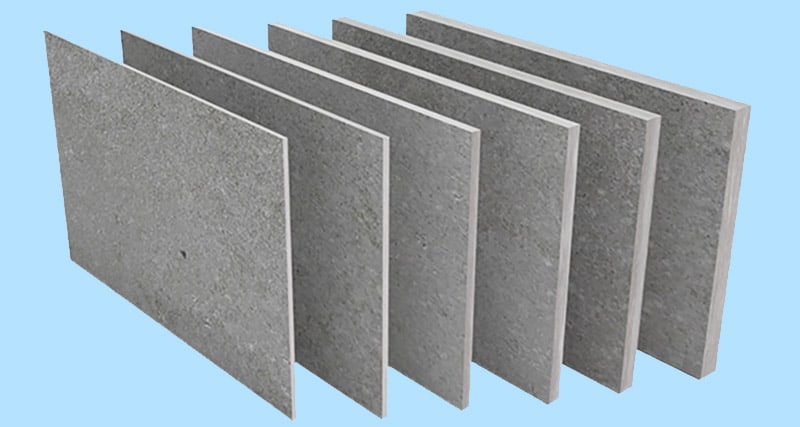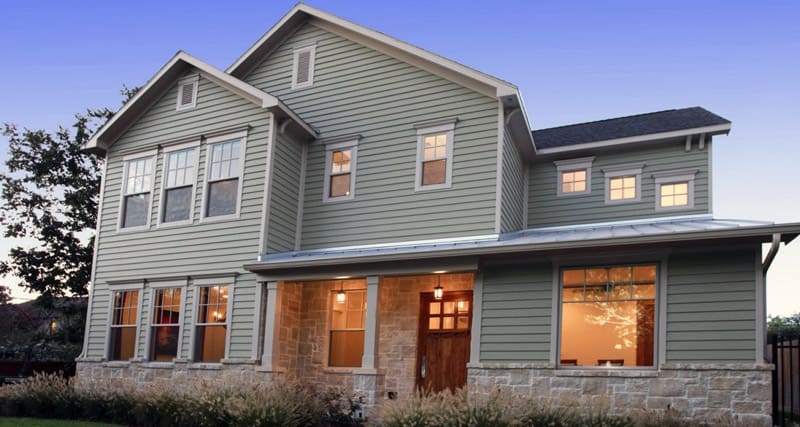It is rightly said that ‘first impression is the last impression’. More so, when you’re building or renovating your house.

It’s not only the inside that matters but also how it appears from the outside. It is necessary to have firm outer layer on the exterior walls that withstand a lot, from sun to dust and wind.
Now, there are many types of siding materials to choose from, but arguably one of the most popular options is fiber cement siding!
What is fiber cement siding?
The fiber cement siding is not made up of fibers or some other scientific synthetic material as you might think. Fiber cement consists of 4 major ingredients:
- Wood Pulp: Provides flexibility and resilience to the siding
- Fly Ash or Silica Sand: Used as a filler
- Portland Cement: It comprises limestone, clay and iron and works as a binding agent
- Water: Dissolves the wood pulp and activates & hardens the cement

Now that you know how fiber cement is prepared, your decision about whether or not to use this material depends on the pros and cons of fiber cement siding, and your needs. Read on to find out the various advantages and disadvantages of fiber cement siding.
Pros of Using Fiber Cement Siding
Durable
Fiber Cement sidings gained popularity majorly because of their durability. It is very inconvenient to keep changing the exterior sidings often. Experts believe that it is the most resistant material to common enemies of residential siding.
The material doesn’t rot or warp and also is crack-resistant. UV exposure does not degrade it and it resists hail, snow and ice. One of the alternatives to fiber cement siding – wood siding has a common problem of pest and termite attacks which isn’t a problem for fiber cement sidings. All these together make up for fiber cement siding’s durability.
Low Maintenance
Fiber cement siding, as mentioned above, is resistant to insects, fungus, and UV damage. You can simply clean it regularly with a power washer. And whenever you’re ready for a change, this material is easy to paint.
Versatile
Due to the cement components used for manufacturing, one can mould fiber cement siding to take on a very wide range of styles and shapes. If you love the look of wood, stucco, or any other common material type but want something more durable and eco-friendly, then fiber cement is the way to go.
Environmentally Neutral
Although the siding isn’t recyclable, per se, but unlike the other sidings that are made up of PVC, the ingredients of fiber cement siding are environmentally inert and do not degrade into any damaging or toxic substances. Hence, it is considered as one of the most eco-friendly siding options.
Fire Safety
Fire is something that should never be underestimated. Unlike a wooden siding, it is not prone to catching fire. Fiber cement siding is unaffected by both heat and flame and has a Class 1(A) rating for fire/flame spread which is the highest available rating.
After coming across the various advantages of using fiber cement siding, it is also very important to know the cons in order to make a well-informed decision.

Cons of Fiber Cement Siding
Cost
Although fiber cement siding is not the costliest material available in the market but its prices are relatively higher than many of its counterparts, like vinyl sidings. The higher cost is majorly due to the long lifespan of the fiber cement siding.
Installation
To install the siding you need to hire professional installers since it is heavy and is prone to breakage.
Here is an overview video on how to cut and install fiber cement siding:
When comparing the pros and cons of the fiber cement siding, it is very clear that it has way more advantages and suits almost all your needs that make it a very suitable siding option for you.
The only decision post this is where to buy the siding from and which style to pick up, for which you have a number of options available around you.
So, just go ahead and get your walls the support and appearance of your choice that will stay for a long, long time.
How Much Does It Cost to Side a 2000 Square Foot House with Fiber Cement?
Fiber cement siding has become an attractive choice. People pay between $5 to $20 per square foot for a professional to install it, and this will usually include the cost of all of the materials, the labor, the permits, debris removal, and the warranty.
For a 2000 square foot house, this is between $10,000 and $40,000. The actual price will vary depending on where your home is, how difficult it is to access the home, and its exact size. The job might include the removal of the existing siding, which will add to the cost.
How Long Does Fiber Cement Siding Last?
When people install new siding on their homes, they factor in how long it is likely to last. Fiber cement siding is newer than other types, but it is quickly becoming a popular option.
It is attractive and durable, and it is one of the longest lasting products available. Fiber cement siding is made up of a composite of cement, wood pulp, water, and filler.
It is insect, fire, moisture, and UV resistant. Manufacturers usually offer warranties of between 30 to 50 years, which means that if you have it installed and maintained according to the manufacturer’s guidelines, it should last at least this long (and even more).
How Often Should Fiber Cement Siding Be Painted?
You can buy fiber cement siding prefinished or unfinished. If it comes prefinished, you won’t have to paint it for 10 or 15 years.
If you install it unfinished, you should paint it soon after the installation. Then, you will get 10 to 15 years out of the paint job before you need to paint it again.
The material in fiber cement siding has great adhesive qualities, which is why the paint job can last so long.
It is important to make sure that you use a quality exterior acrylic based paint to get the most out of your paint job.
Oil-based paints are not advised, as they can discolor or crack within a year, and latex may fade with the UV light exposure. When you use the right paint, it will last between 10 and 15 years.
Does Fiber Cement Siding Rot?
Fiber cement siding is made using cement, wood pulp, water, and filler, and it generally doesn’t rot. Rot can destroy the siding on your home, and the way it grows is by absorbing moisture.
Fiber cement siding is water resistant, so it isn’t affected by moisture the way that wood and other materials are.
However, it is important that the siding is installed correctly. If there are cracks or other openings left after it is installed, there will be spaces where moisture can get inside, which allows rot to grow.
Make sure that you have a professional installation by a contractor who knows what they are doing, and you won’t have problems with rot when you use fiber cement siding.
Does Fiber Cement Siding Increase Home Value?
Whenever homeowners consider improvements, they look for options that increase the value of their homes.
Fiber cement siding is strong and durable, and it is becoming quite popular. As a result, buyers consider this to be a benefit when they are looking at a home. Installing the fiber cement siding correctly can update your house and protect it from moisture and rot.
It is easy to paint compared to other surfaces, and it resists pests, fire, UV light, and moisture. All of these benefits do increase your home’s value.
What Is Hardie Board Siding?
Hardie Board siding is a name for a brand of fiber cement siding. It is the James Hardie fiber cement siding, and it is the top selling brand for this type of siding.
It is very durable, and it looks great, lasts a long time, and comes with a warranty that lasts 30 years. It resists moisture penetration, so you save money on repairs and maintenance, and it looks attractive. It comes in a number of styles and colors.
It also resists damage from termites and woodpeckers, and you can customize the look of your home. Fiber cement siding is growing very popular, and Hardie Board siding is one of the most popular brands.
Related Posts
- 15 Main Pros and Cons of PVC Decking – Comparison and Discussion
- 12 Different Types of Wood for Outdoor Furniture with Pros/Cons
- 11 Different Types of Natural Stone for House Exterior
- Advantages and Disadvantages of Composite Decking for Homes
- What Color Siding Goes With Red Brick? Design Ideas With Pictures
- 8 Unique Porch Ceiling Ideas for your Home (with Photos)
I am looking at finishing my tiny master bathroom. I removed the old tile and drywall and put up mold resistant green board. ( Home Depot said concrete board wasn’t necessary)
I thought I could put beadboard up on my own and have found that I was mistaken! What a fiasco! Warped boards and frustration!
At any rate, I have been living with it as it is… unfinished and partially demolished. Ughhh. Why did I think I could do this easily!?
Sooo, It just occured to me.. Concrete siding!
Can concrete siding be used as an alternative to tile in the entire bathroom shower tub area?
Hello,
Fiber cement is great as backing for tiles in the bathroom. However, it might be used also in the shower but you must ask the manufacturer/seller. Some types can be used, some others can’t.